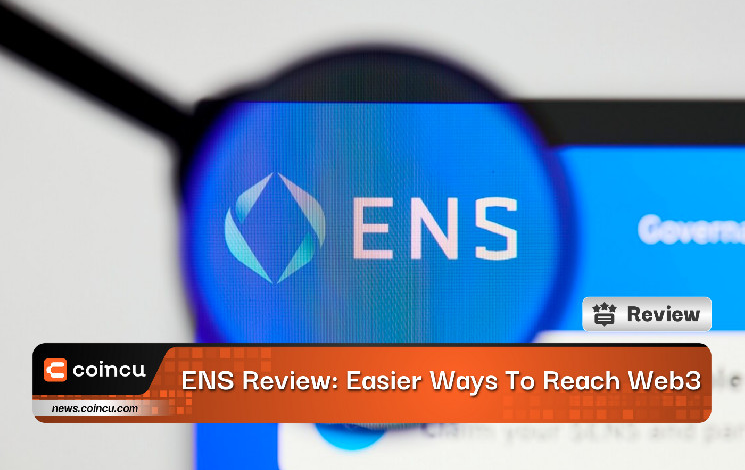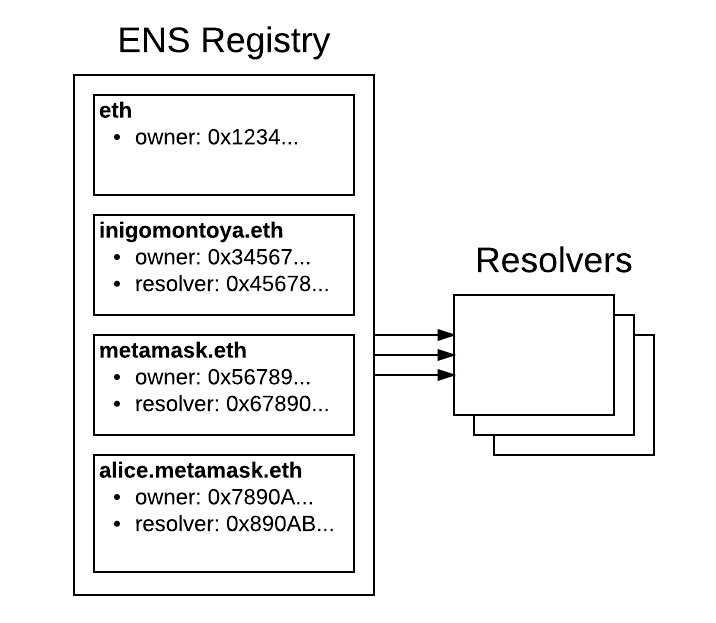ENS Review: Easier Ways To Reach Web3

Blockchain
Instead of remembering each friend’s phone number, you can now just go to your contacts. Insert their name and phone number. It is much simpler to remember and much handier to save each phone number with its own name.
That is analogous to transmitting money in cryptocurrency using wallet addresses.
The public key is the address where the coin is received. That is pretty lengthy and tough to recall. To deposit bitcoin, scan their QR code or copy their unusually lengthy wallet address (0x85b3…).
ENS was created with the goal of making it easier to transmit funds to another address. And can do a variety of other functions. ENS is regarded as one of Ethereum’s earliest initiatives. It is still popular today because of the advent of a slew of Web3 projects.
Today, let’s dive deeply into this topic with Coincu.
Overview
The internet as we know it now is not the same as it was when it first appeared. One of the most pressing issues during the early stages of the internet’s development was accessibility.
Prior to the introduction of domain names, visitors had to input the website’s whole IP address to access it. IP addresses are a long string of digits and dots that may be tough for the typical user to remember. The advent of the Domain Name System in 1983, on the other hand, shifted the narrative of internet accessibility.
DNS’s functions are centered on the alignment of IP addresses and human-friendly domain names. As a consequence, instead of long IP addresses, consumers may visit websites simply typing in the website’s name.
The Ethereum Name Service was also created with the goal of simplifying the approach to blockchain addresses, which is often misunderstood (at least for newcomers).
What is Ethereum Name Service?
Ethereum Name Service (ENS) is an open-source, decentralized system based on the Ethereum Blockchain. It has a naming system that enables users to link human-readable names such as “coincucrypto.eth” to machine-readable identifiers such as Ethereum addresses.
The goal of ENS is to make it easier to connect with and access decentralized apps (dApps) and smart contracts on the Ethereum network.
From its inception, cryptocurrency has used a very complicated system to monitor and locate wallets, comparable to the IP address scheme.
When ENS was introduced, the problem was solved. It enabled users to transfer cryptocurrency to any wallet without having to type in the whole wallet address. It translates human-readable domain names into Ethereum addresses. This enables users to replace large and complicated Ethereum addresses with a short, easy-to-remember domain name.
To resolve domain names and get Ethereum addresses, ENS runs as a distributed system, depending on a network of nodes. Domain name resolution is managed by a decentralized auction mechanism in which the highest bidder is awarded the right to use the domain name.
Users may quickly access decentralized apps, smart contracts, and other services connected with Ethereum addresses by using ENS.
Removing the need for long and complicated Ethereum addresses may enhance the overall user experience. The Ethereum Name Service is altering Web3, and brands are actively participating. These companies provide blockchain technology training to those who want to work for them.
ENS is significant in crypto because its use case is more extensive than reduced complexity. Yet, unlike the DNS, it is not vulnerable to security vulnerabilities. Unlike the DNS, the data on an ENS address is kept on a decentralized Ethereum blockchain, leaving it vulnerable to hacking attempts and other flaws. It facilitates and transparently interacts between brands and their client base.
This makes ENS an appealing option for corporations and enterprises wishing to offer security to their users. Companies will also need individuals with Ethereum training and the required abilities to assist them in establishing a foothold on Web3.
When you register a .com domain name, you use a domain name registrar, who updates ICANN’s database, the international body that organizes internet resources such as top-level domains (TLD).
When you visit a website in your web browser, the domain name service (DNS) translates the name into an IP address that corresponds to the server where the website data is stored.
ENS has similar purposes to DNS, the Internet’s domain name service, but has a radically different design owing to the Ethereum blockchain’s capabilities and limits.
ENS, like DNS, is based on a system of dot-separated hierarchical names known as domains, with the domain owner having complete authority over the subdomains.
Top-level domains, such as ‘.eth’ and ‘.test,’ are held by smart contracts known as domain name registrars, which describe the rules regulating subdomain allocations.
Anybody may get ownership of a domain name for their own use by following the requirements established by these domain name registration agreements. ENS also allows users to import DNS domains that they currently own for usage on ENS.
Since ENS is decentralized, anybody who owns a domain at any level may arrange subdomains for themselves or others as they see fit. For example, if we control the domain coincu.eth, we may set up news.coincu.eth.
ENS is live on the Ethereum mainnet as well as various test networks. Whether you use a library, such as the ensjs Javascript library, or an end-user application, it will automatically identify the network and utilize the ENS implementation on that network.
How does Ethereum Name Service work?
A Registry and Resolver are the two main components of ENS. A registry is a smart contract that keeps track of domain names and Ethereum addresses. Domain names are resolved to their matching Ethereum addresses via resolvers.
When a user wishes to register a domain name, they submit a transaction to the smart registry contract specifying the desired domain name and the Ethereum address to which the domain name should be resolved. The registrar will keep the domain name mapping to the Ethereum address after the transaction is validated.
The ENS Registry is made up of a single smart contract that keeps track of all principal “domains” and subdomains “subdomains” and saves three critical pieces of data:
An external account (user) or a smart contract may be the domain owner. A registrar is just a Smart Contract that owns a domain and assigns subdomains to users based on a set of criteria established in the contract.

Domain registrant in ENS registration:
- Configure the domain’s resolver and TLL
- Transfer ownership to another location
- Subdomain ownership may be changed.
The ENS registration cycle is straightforward, and it exists to form a name from the resolver. The resolvers will be in charge of translating the name into an address. Every qualifying contract will be able to interface with the resolver.
The Rosolver is in charge of the actual process of converting names to addresses. Under the ENS, any contract that implements the required standards may operate as a settler for customers with basic needs, such as giving a regularly changing address for a name, and general-purpose resolver implementations are given.
Why is it needed?
ENS development is geared toward transforming user names into identifiers on the Ethereum network, which are then utilized as wallet addresses, hash content, and application metadata.
Simply, when users enter conventional wallet addresses into ENS, they are transformed into the .eth extension for their convenience.
The project also supports reverse resolution, which enables metadata sources with canonical names or interface descriptions to be linked along with Ethereum wallet addresses.
The key features of Ethereum Name Service showed how it may solve the issue of lengthy addresses. It intends to make it easier for users and apps in the coming Web3 context to read and communicate crypto addresses. The maturation of Web3 might lead to additional advancements in the possibilities for new ENS protocols.
How is DNS different from ENS?
DNS operates by turning a web server’s IP address into human-readable names known as URLs. Ethereum Name Service, on the other hand, converts Ethereum addresses into human-readable strings that resemble URLs.
As a result, several operations of the ENS Ethereum are comparable to those of DNS. Both of them function similarly to a phonebook and might assist you in obtaining the number to contact a certain person. It is also critical to understand how DNS plays a key role in the smooth operation of Web2 systems. The Domain Name System is a major feature in the collection of internet technologies that allow for continuous internet access.
On the other side, the rise of Web3 has prompted further breakthroughs via web decentralization. Nonetheless, Web3 has substantial adoption challenges, such as lengthy addresses, which complicate user experiences. ENS has partially overcome this conundrum by making Web3 access easier and more comfortable.
ENS Token
Key Metrics ENS
- Ticker: ENS
- Blockchain: Ethereum
- Token Standard: ERC-20
- Contract: 0xc18360217d8f7ab5e7c516566761ea12ce7f9d72
- Token Type: Utility, Governance
- Total Supply: 100,000,000 ENS
- Circulating Supply: 20,244,862 ENS
Token Allocation
- DAO Community Treasury: 50%.
- ENS Contributors: 25%.
- Airdrop for .eth holders: 25%
Use Case
The token can be used in project management, participating in activities on the platform or airdrop for users.
Conclusion
ENS is important in the blockchain and crypto industry because it simplifies access to decentralized apps and smart contracts. To keep ahead of the competition, anybody wishing to extend their portfolio will need to upskill and learn about ENS. For organizations aiming to extend their presence in the web three domain, ENS is an appealing investment; qualified people in the industry are in great demand.
If Web3 really erupts in the same manner that Web2 did, the domain name element will be one of the most important components in igniting a new revolution.
However, there are alternative domains on the market, such as .near, .sol,.crypto, .bitcoin, .wallet, or the new emergence of the BNB Chain Space ID initiative. However, .eth continues to dominate and is now the most popular domain name.
DISCLAIMER: The Information on this website is provided as general market commentary and does not constitute investment advice. We encourage you to do your own research before investing.





